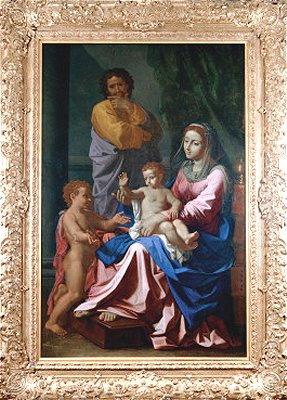 |
|
The Holy Family with Infant John the
Baptists
Nicolas Poussin, French 1594-1655
SN 361, Oil on Canvas
by Robert Anderson.
Artist:
Nicolas Poussin, who was active primarily in Rome, is regarded not only as the greatest
French painter of the 17th century but also as the mainspring of the Classical tradition
in French painting. He was influenced by Titian's work until about 1633 when he moved to a
more austere classicism which recalls Raphael and Giulio Romano. He became preoccupied
with the depiction of emotion by the gestures, pose and facial expression of his figures.
On an otherwise brief unhappy visit to Paris (1640-42) he came into
contact with the intellectual bourgeoisie who became patrons for the rest of his life.
Over the next decade he painted for these patrons the works which are considered the
purest examples of the Classical spirit. In this Poussin believed that painting must
present noble and serious human situations in an orderly manner with appeal to the mind
and not the eye. Trivial sensuous allures such as glowing colors were not acceptable.
Poussin had a practice of preparing his compositions with the aid of a shadow box or a
model stage filled with wax figures. By rearranging the figures and lighting he was able
to produce drawings notable for their controlled but emotionally effective choreography. |
Notable works included The Seven Sacraments, with contrasts of light and
dark ; Dance to the Music of Time, in which Music, Poetry, and Dance were brought together
in a painting ; Landscape with Diogenes which gives an expression of mood in which the
harmony of nature and the virtue of man are explored. Landscapes are presented as if they
were architectural constructions, with clearly defined planes within a finite enclosed
space.
During the 1650's Poussin's depiction of religious subject matter became
more poignant and his capacity to go to the heart of the subject matter reached a new
level of intensity. The Ringling Holy Family, for example, is the most grandiose and
severe in conception of all of the Holy Families he painted. This maniera magnifica or
magnificent style lasted from about 1655 to his death some ten years later.
Subject:
This painting depicts the Holy Family with John the Baptist who is portrayed as a young
boy. The Christ child on Mary's lap appears to bless the young John who in opening his
arms seems to recognize the Christ as his saviour. Joseph's reflective pose evokes a
philosophic sense of wonderment and mystery.
Painting:
This painting has been described as one of Poussin's finest works. It is an excellent
example of Poussin's mature style and demonstrates his careful study of Raphael and
antique sculpture.
The Virgin seated on a sturdy throne, holds the Infant Christ on her lap
with St. John kneeling on her footstool. John opens his arms in an gesture of adoration as
he is blessed by Christ. St.John's right hand motions outward to the viewer to allow us to
participate in the blessing. Joseph leans on his staff in the background , one hand
covering his chin in contemplation. Poussin, in this painting, emphasizes the tender
expression of the Virgin and the gentle interplay between the blessing by Christ and St
John as he recognizes Him as his saviour.
There is a wonderful harmony of cool dusty pinks and deep blues in the
Virgin's robe, set off against the dark forest green of the drapery behind her and the
grey-violet and gold of Joseph's gown and mantle.
The figures are solid and monumental and seem frozen in place. They have a
weighty solemnity and timeless quality found in the best classical sculpture. Poussin
achieved this effect by interpreting every form in terms of geometric solids and voids.
For example, the Madonna and Child can be inscribed neatly within a triangle - the figure
of Joseph is as solid and cylindrical as the column next to him. Poussin used strong
contrasts of light and shadow to enhance this effect of solid sculptured forms.
Historical Context:
This grandeur and simplicity, which appeals more to the mind than the senses is
characteristic of 17th century Classicism, in contrast to the painterly virtuoso
performance of a Baroque artist like Rubens. This classicizing style was to have
tremendous impact in France and reached its most perfect moment in the paintings of Jaques
Loius David over a century later.
|
